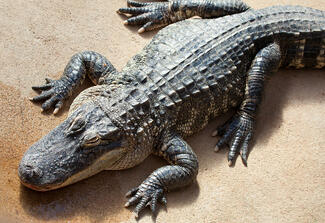Welcome to the second installment of the crocodilian leather series! Here, we’ll tackle the makeup, size and characteristics and leather quality of the American alligator (alligator mississippienis). Native to the American southeast, this gator is found in freshwater habitats as west as Texas and as north as the Carolinas (but predominantly Florida and Louisiana).

The Animal
American alligators can reach lengths upwards of 20 feet and can weigh up to 1,000 pounds! Normally, most of this specie sis about 8-10 feet long, fully grown.
The alligator can be told apart by its tooth placement. Most crocodiles tend to have their fourth lower-jaw tooth placed on the outside when their mouths are closed, but alligators have a place for it inside their mouth. Another tell-tale sign of their difference is with their snouts. Gators will have rounder noses (U-shaped) whereas crocodiles will have sharper, more pointed noses (V-shaped).
Like their crocodile counterparts, the American alligator faced extinction at one point in time. However, due to massive efforts called “conservation through utilization,” we’ve been able to protect them to continue their existence in safer, healthier habitats. About 200,000 of these alligators from farm-raised environments are used for leather projects, whereas 50,000 are collected annually from the wild.
The Skin
The plates on the alligator skin have relatively little bone. Their belly scales are medium-to-large sized and do not have the follicle marking (single dot) that you can find on the belly scales of several other croc species. The alligator skin has a large flank section (in terms of both width and length) and long and narrow belly section compared to other related species. The tails on alligators also tend to be wider than tails on a similar size crocodile of another specie.
Using Alligator Hide on Your Next Leather Project
The lack of bone and follicle markings on the belly scales give the alligator skin a very clean look, ideal for handbags and luxury accessories. The wider tail also makes the yields attractive for watchtraps and footwear.

The availability of lower grade wild skins also makes using alligator skin economically feasible for products like belts and small leather goods that allow you to cut around defects, since lower grade wild skins are typically less expensive per usable area than top grade farmed skins.
No matter the use of your alligator skin, it will likely be an easy process to make your product. The skin of an alligator is soft and very flexible which makes for simple, hassle-free craftsmanship that’s bound to amaze your end consumer.
For more information on alligator skin — or any other exotic leather for that matter — be sure to contact one of our expert representatives. We’ll give you the full rundown of each and every kind of material to help you select the perfect material of your next leather project!
If you want more information on alligator skin, be sure to download our FREE Alligator Skin Guide right here.



